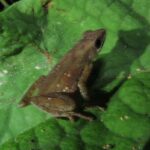- Exploring the Secretive World of Ischnocnema surda: Brazil's Enigmatic Forest Frog
- Taxonomy and Classification: Unraveling the Frog's Identity
- Natural Habitat: The Hidden World of Ischnocnema surda
- Physical Characteristics: The Art of Subtle Beauty
- Behavior and Life Cycle: Adaptations in Forest Shadows
- Ecological Role: Quiet Engineers of Forest Health
- Threats and Conservation Status: Protecting the Unseen
- Cultural and Scientific Significance: Why the Unnoticed Matter
- Conclusion: Stewardship for the Silent Forest Frog
Exploring the Secretive World of Ischnocnema surda: Brazil’s Enigmatic Forest Frog#
In the lush, humid shadows of Brazil’s coastal rainforests lurks a creature almost unnoticed, yet truly remarkable: Ischnocnema surda. Known by few, yet captivating to those who study them, these modest, understated frogs play a vital role within their vibrant ecosystem. Although small in size and elusive in nature, their intriguing behaviors and specialized adaptations present a fascinating story that speaks volumes about the subtle wonders of biodiversity hidden within Brazil’s rich forests. Few creatures illustrate so vividly how even the tiniest organisms can influence the health and vitality of complex ecosystems.
Discovered relatively recently and documented thoroughly only within recent decades, Ischnocnema surda embodies the hidden wonders still awaiting our observation and understanding. Beyond its scientific significance, this frog reminds us why conservation is paramount, revealing the delicate balance required to sustain even the most overlooked species. Let’s step quietly into its verdant home and illuminate the life of this fascinating amphibian.
Taxonomy and Classification: Unraveling the Frog’s Identity#
The scientific journey to understand Ischnocnema surda begins with taxonomy—the precise art of scientifically naming and classifying organisms. Belonging to the family Brachycephalidae, a lineage of direct-developing frogs known for their independence from aquatic environments during their reproductive cycle, Ischnocnema surda‘s identity is marked by its remarkable adaptation to terrestrial survival.
First described by Mirco Solé and Ulisses Caramaschi in 2006, Ischnocnema surda belongs prominently within the diverse genus Ischnocnema. This genus includes a variety of direct-developing frogs, meaning they bypass the familiar tadpole stage that is characteristic of many amphibian life cycles. Instead, their offspring hatch directly as miniature froglets, a notable adaptation that allows them to thrive independently of standing water—a true survival marvel in Brazil’s perpetually moist but unpredictable forest environments.
Natural Habitat: The Hidden World of Ischnocnema surda#
Geographic Range and Distribution#
To meet our elusive subject, we venture into Brazil’s coastal Atlantic Forest (Mata Atlântica), a biodiversity hotspot renowned globally for its extraordinary variety of flora and fauna. Native solely to this endangered ecosystem, Ischnocnema surda inhabits small, fragmented forested areas within the Bahia and Espírito Santo states, a region threatened by long-standing processes of deforestation and human encroachment.
Preferred Habitat#
Under dense foliage canopies and within humid leaf-litter, Ischnocnema surda finds its ideal environment. Preferring lowland and montane rainforest habitats, these frogs shelter among layers of decomposing plant matter, beneath logs, or near moss-draped rocks. It’s an environment rich in moisture, warmth, and insect prey, precisely suited to their ecological niche. Adaptation has made this terrestrial frog exceptionally attuned to the temperature fluctuations, humidity levels, and resource availability of a forest system perpetually under threat.
Physical Characteristics: The Art of Subtle Beauty#
Though modest in size—typically measuring just around 2-3 centimeters—Ischnocnema surda boasts significant charm upon close observation. Its coloration varies subtly across individuals and populations, typically featuring an earthy blend of browns, grays, and subtle greens marked by darker patterns and camouflage patterns. This muted coloration provides essential concealment against the leaf litter, allowing them to blend seamlessly into their surroundings and evade predator eyes.
Their skin texture is rugged, no longer the slippery classic stereotype associated with frogs. Instead, it appears slightly granular, offering an improved camouflage advantage in the gentle gradients of woodland debris. Their limbs are long and slim, fashioned delicately but purposefully, optimized for quick movements through their textured surroundings. Notable also are the folds along the back and sides, enhancing camouflage by mimicking curled, dying leaves.
Behavior and Life Cycle: Adaptations in Forest Shadows#
Feeding and Predation Strategies#
An adept hunter, the secret to Ischnocnema surda‘s daily survival lies in its patient, and largely unseen feeding habits. Primarily insectivorous, these resourceful creatures capture a wide range of small prey, including ants, mites, spiders, and beetles, each abundant within the leaf-litter microhabitat where they reside. Their hunting method is patient and stealthy—waiting motionlessly amongst leaf litter until the perfect moment to snap prey swiftly with their sticky tongues.
Direct Development: Life without Tadpoles#
Perhaps the most fascinating element of their biology is their reproductive strategy. Unlike many frog counterparts that lay eggs in water, resulting in tadpole larvae, Ischnocnema surda young undergo direct development, skipping the aquatic phase entirely. Eggs are laid exclusively among damp leaf litter, where they hatch not as aquatic tadpoles, but directly into tiny froglets closely resembling their adult form.
This formidable adaptation releases the species from reliance on standing water bodies; thus, they can reproduce even in microhabitats devoid of permanent streams or ponds. Such evolutionary flexibility embodies resilience—essential for survival amidst environmental stressors and habitat fragmentation.
Ecological Role: Quiet Engineers of Forest Health#
While small and often unseen, Ischnocnema surda plays crucial roles within its forest ecosystem. Serving as both predator and prey, they balance insect populations and provide sustenance for larger predators—snakes, birds, and larger amphibians—thus illustrating their active participation within complex food networks.
Ecologically, their health also directly indicates the state of their habitat. Amphibians are widely recognized as indicator species, their sensitivity to pollutants and environmental shifts providing clues about ecosystem integrity. Declines or disruptions in populations of Ischnocnema surda may signal larger ecological problems that require urgent conservation attention.
Threats and Conservation Status: Protecting the Unseen#
Unfortunately, the incredible biodiversity inhabiting Brazil’s Atlantic Forest—including Ischnocnema surda—faces sustained pressures, mainly through habitat destruction caused by urbanization, logging, agriculture expansion, and climate change. Fragmentation reduces genetic diversity and population connectivity, significantly diminishing resilience and making populations more vulnerable.
Currently assessed by the International Union for Conservation of Nature (IUCN) as “Data Deficient,” the species urgently demands further research. Conservationists stress the critical need to gain deeper ecological data to create effective preservation strategies. Protecting their rainforest habitat compartments, controlling further deforestation, and fostering habitat corridors to encourage gene flow among population pockets all form essential components of conservation objectives.
Cultural and Scientific Significance: Why the Unnoticed Matter#
While Ischnocnema surda may not hold great symbolic significance in local folklore, its scientific relevance is enormous. The species contributes invaluable biological data concerning direct frog development, soil ecosystems, and biodiversity management. Furthermore, as indicator species, these small amphibians provide vital evidence for broader environmental trends, alerting scientists and policymakers to issues affecting ecosystem health and stability.
Moreover, enhancing public understanding of such lesser-known frog species can foster an emotional connection, raising awareness and heightening conservation advocacy. Inspiring curiosity and enthusiasm toward these overlooked creatures fuels grassroots support crucial to long-term conservation success.
Conclusion: Stewardship for the Silent Forest Frog#
The humble presence and ecological vitality of Ischnocnema surda underscore a powerful conservation lesson: even nature’s quietest voices carry significant importance. Protecting these tiny frogs equates not merely to saving a single species but preserving the intricate web of rainforest life they help sustain and indicate.
As conscientious naturalists, students, and nature-enthusiasts, our ongoing mission involves raising awareness, conducting critical scientific research, and advocating for habitat preservation. The conservation journey of Ischnocnema surda can serve as a rallying call—a reminder that even hidden wonders deserve protection, research, and love. After all, conservation efforts aimed at safeguarding the tiniest residents ultimately safeguard the health and beauty of our shared global heritage.







